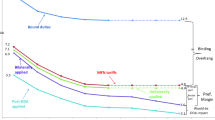Abstract
Despite the much-touted celebration of the successes of the General Agreement on Tariffs and Trade/World Trade Organization in liberalizing free trade, these successes have been limited due to the increasing use of non-tariff barriers (NTBs) as a form of ‘protectionism in disguise.’ Among advanced industrial economies, the use of NTBs varies considerably. The purpose of this paper is to explain what accounts for this variation. We locate the issue of international trade in its appropriate theoretical context — as a two-level game in which politicians simultaneously face pressure at the international level to fulfill commitments to international free trade agreements, and domestic pressures for protectionist relief. We conduct a statistical analysis using a simple, multivariate regression model examining data at three points in time, 1988, 1993, and1996, to highlight the causes of the rise in NTBs and variation in their usage. We hypothesize that PR-based systems are associated with lower rather than higher levels of NTBs.

Similar content being viewed by others
Notes
The term ‘non-tariff barriers’ to trade include measures other than tariffs that may be used by countries to restrict imports. For the purposes of this study, we use the definition of NTBs employed by the Organization for Economic Cooperation and Development (OECD) database (OECD, 1996, 63).
References
Bergsten, C.F. and Cline, W.R. (1983) Trade Policy in the 1980s, Cambridge, MA: MIT Press.
Busch, M.L. and Reinhardt, E. (1999) ‘Industrial Location and Protection: The Political and Economic Geography of U.S. Non Tariff Barriers’, American Journal of Political Science 43 (4): 1028–1050.
Cowhey, P.F. (1993) ‘Domestic Institutions and the Credibility of International Commitments: Japan and the United States’, International Organization 47 (2): 299–326.
Crepaz, M. (1992) ‘Corporatism in Decline? An Empirical Analysis of the Impact of Corporatism on Macroeconomic Performance and Industrial Disputes in 18 Industrialized Democracies’, Comparative Political Studies 25: 139–168.
Deardorf, A.V. and Stern, R.M. (1998) Measurement of Nontariff Barriers, Michigan, Ann Arbor: The University of Michigan Press.
Evans, P., Jacobson, H. and Putnam, R. (1993) Double-Edged Diplomacy: International Bargaining and Domestic Politics, Berkeley: University of California Press.
Greenaway, D. (1980) Protectionism Again…?: Causes and Consequences of a Retreat from Freer Trade to Economic Nationalism, London: The Institute of Economic Affairs.
Heywood, A. (1998) Political Ideologies, London: Macmillan Press Limited.
Huber, E., Ragin, C. and Stephens, J.D. (1997) ‘The Welfare State in Comparative Perspective: Determinants, Program Characteristics and Outcome’, Comparative Welfare Dataset. Northwestern University and University of North Carolina.
Katzenstein, P. (ed.) (1978) Between Power and Plenty: Foreign Economic Policies of Advanced Industrial States, Wisconsin: Wisconsin University Press.
Keohane, R. and Milner, H. (eds.) (1996) Internationalization and Domestic Politics, Cambridge: Cambridge University Press.
Leaner, E.E. (1990) ‘The Structure and Effects of Tariff and Non-tariff Barriers in 1983’, in Ronald W. Jones and Anne O. Krueger (eds.) The Political Economy of International Trade, New York: Basil Blackwell, pp. 224–260.
Lijphart, A. (1999) Patterns of Democracy: Government Forms and Performance in Thirty-six Countries, London: Yale University Press.
Lijphart, A. and Crepaz, M. (1991) ‘Corporatism and Consensus Democracy in 18 Countries: Conceptual and Empirical Linkages’, British Journal of Political Science 21: 235–256.
Mansfield, E.D. and Busch, M.L. (1995) ‘The Political Economy of Nontariff Barriers: A Cross Sectional Analysis’, International Organization 49 (4): 723–749.
March, J.G. and Olsen, J.P. (1989) Rediscovering Institutions: The Organizational Basis of Politics, New York: Free Press.
Milner, H. (1997) Interests, Institutions and Information: Domestic Politics and International Relations, Princeton, NJ: Princeton University Press.
OECD. (1996) Indicators of Tariff and Non-tariff Barriers, Paris: OECD.
Putnam, R.D. (1988) ‘Diplomacy and Domestic Politics: The logic of Two-level Games’, International Organization 42: 427–460.
Ray, E.J. (1981) ‘The Determinants of Tariff and Nontariff Trade Restriction in the US’, The Journal of Political Economy 89 (1): 105–121.
Rogowski, R. (1987) ‘Trade and the Variety of Democratic Institutions’, International Organization 41: 203–223.
Scaperlanda, A. (1973) Prospects for Eliminating Non-tariff distortions, Nevada: A.W Sijthoff International Publishing Company.
Siaroff, A. (1999) ‘Corporatism in Twenty-Four Industrial Democracies: Meaning and Measurement’, European Journal of Political Research 36: 175–205.
Takacs, W. (1981) ‘Pressure for Protectionism: An Empirical Analysis’, Economic Inquiry 19: 687–693.
Winham, G.R. (1986) International Trade and Tokyo Round Negotiations, Princeton, NJ: Princeton University Press.
Author information
Authors and Affiliations
Corresponding author
Rights and permissions
About this article
Cite this article
Saksena, J., Anderson, L. Explaining Variation in the Use of NTBs in Developed Countries: The Role of Political Institutions. Int Polit 45, 475–496 (2008). https://doi.org/10.1057/ip.2008.20
Published:
Issue Date:
DOI: https://doi.org/10.1057/ip.2008.20




